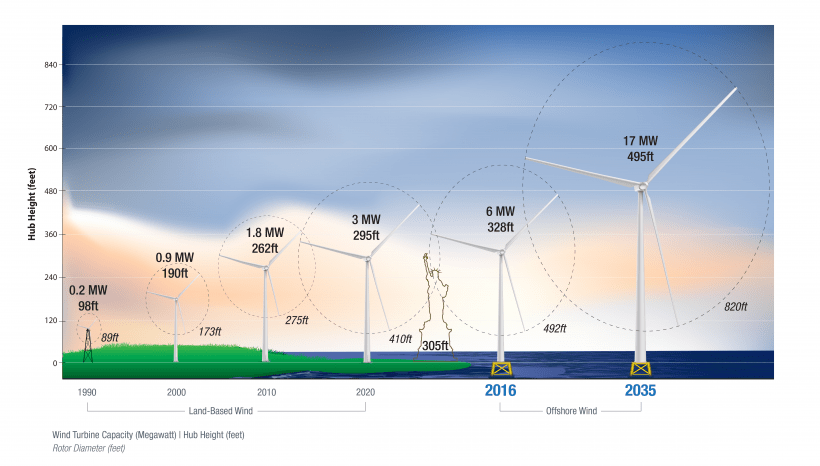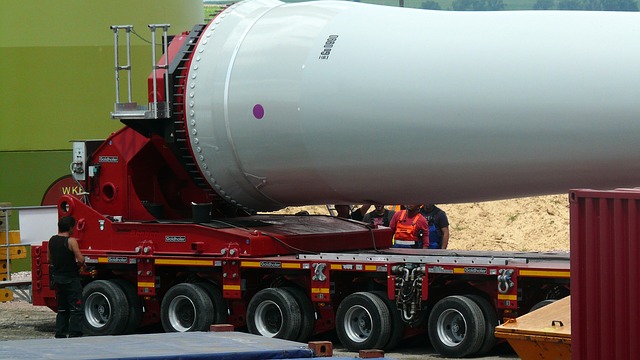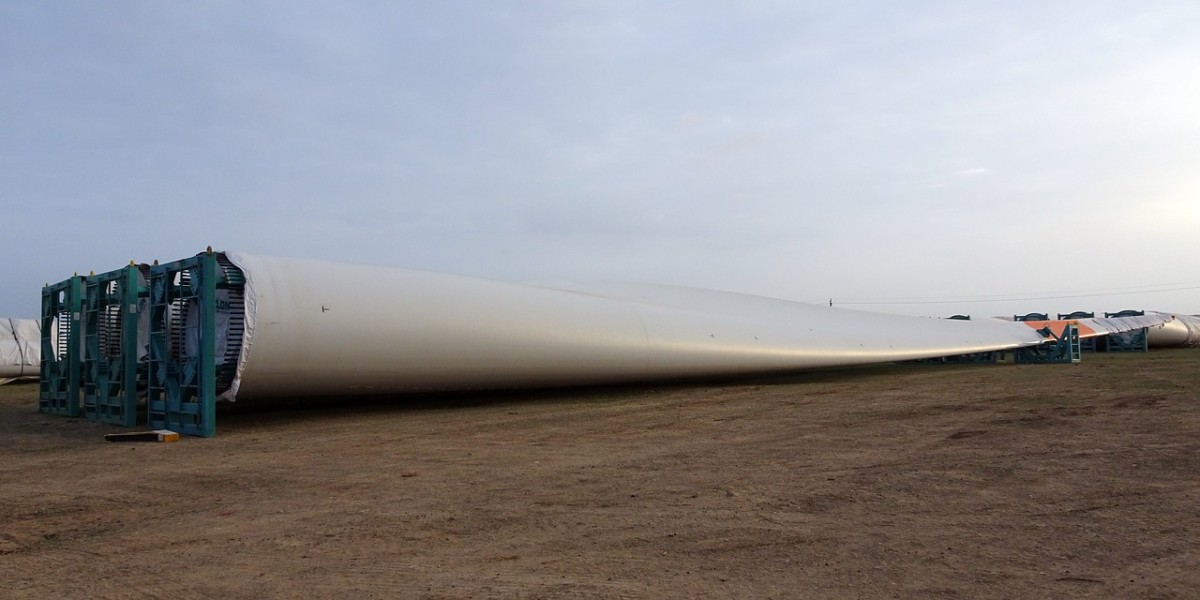How Long Are Wind Turbine Blades?
Experts anticipate significant growth in onshore and offshore turbine size, a wind turbine blades length depends on the size of the wind turbine, local wind speed and local regulations or restrictions.
Wind turbine blade length or wind turbine blades size usually ranges from 18 to 107 meters (59 to 351 feet) long. Depending upon the use of the electricity produced. A large, utility-scale turbine may have blades over 165 feet (50 meters) long, thus the diameter of the rotor is over 325 feet (100 meters)
The largest wind turbine at the time of writing is the GE’s Haliade-X offshore wind turbine, has blades up to 351 feet (107 meters) long! Its production site is in Saint-Nazaire, France.
The GE 4.8-158 is one of the world’s largest onshore wind turbines. Each unit is powerful enough to provide electricity for 5,000 European homes.
What is The Diameter of Wind Turbine Blades?
At the time of writing the average wind turbine blade diameter is about 125 meters (410 feet). This means that larger blade diameters allow wind turbines to be more economical, so that they capture more wind, and produce more electricity.

What Are Wind Turbine Blades Made Of?
A report from the National Renewable Energy Laboratory (Table 30) states, depending on make and model wind turbines are predominantly made of steel (66-79% of total turbine mass); fiberglass, resin or plastic (11-16%); iron or cast iron (5-17%); copper (1%); and aluminum (0-2%).
Most wind turbine blades materials are fiberglass, carbon fibre or aramid (Kevlar) heated together with resin to combine into a material that is light and yet still strong enough to withstand intense storms. Also being investigated is the possible use of wood compounds, such as wood-epoxy or wood-fibre-epoxy.
How Often Do Wind Turbine Blades Have To Be Replaced?
Most wind turbine blades are replaced after around ten years they are replaced with modern, more powerful turbine blades designs. However, that is just half the wind turbine blades lifespan as turbine blades could last 20-25 years. Next let’s look at why do wind turbine blades wear out.
So, how long do wind turbine blades last really depends on these factors. The main reasons for wind turbine blades to be replaced after approximately ten years are higher levels of loading and fatigue, damage from bird or lightning strikes and high winds loads. Their performance largely diminishes by about 1.6% per year.
How Are Wind Turbine Blades Transported?
Wind turbine blades and wind turbine components are usually transported by ship, rail and truck. Once the wind turbine blades arrive at a shipping port they are unloaded onto the rail system or trucks to be taken to their destination.
With the extreme length of turbine blades and a single blade weighing up to 12 tons this can lead to some restrictions when planning a route via highways, this is overcome by coordinated road transport projects. To overcome sharp turns and intersections specialized equipment is utilised including RGN trailers, these trailers are fitted with steer axles.

At the time of writing most railroad cars have a length of 89 feet and modern wind turbine blades are exceeding 110 feet, also the height of the blades themselves cause problems as they may be too high to pass through rail tunnels or under bridges. So, will we need to increase the size of our railroad cars in the future?
How Much Does It Cost To Transport A Wind Turbine Blade?
To transport turbine blades from place of manufacture or shipping port to the required site, such as a wind farm will realistically cost in the region of up to $150,000. But as blades get evermore larger so will the cost of transportation.
Can wind turbine blades be recycled?
Wind turbines come with a pile of large, dangerous blades. If the wind turbine has not been decommissioned and is an outdoor unit, it can be dismantled by dismantling the mechanisms that control the blades, then removing all the blades. The individual parts must be kept in a safe place until they are recycled into something new.
How do you dispose of wind turbine blades?
The recycling process of fiberglass wind turbine blades starts with the collection of used blades. The blades are then transported to a recycling facility where they are sorted and dismantled. The composite is then separated from other materials, such as steel, using a water jet or shredder.
After the separation process, the fiberglass can be used to produce a variety of products. The use of recycled fibers in concrete is becoming more common because it helps reduce greenhouse gas emissions and is more environmentally friendly than using virgin materials.
Another way to dispose of wind turbine blades is by recycling them into other products, such as power poles. The used blades are cut into smaller pieces and heated in an industrial furnace until they become a usable form.
To recycle wind turbine blades safely, it is important to follow all local regulations regarding the handling and disposal of hazardous materials. It is also critical to use the proper tools and equipment, such as a water jet or industrial furnace, to ensure that any reusable materials are properly separated from other components. Wind turbine blades can be reused in many different ways once they have been properly decommissioned and recycled.
Things to know when dismantling your own material wind turbine
- Always put safety first; use proper work gloves and eye protection when handling any part of your wind turbine.
- Always be sure to collect all the little bits of metal from the blades and other parts.
- Keep little kids and animals away from the work area.
- Make sure you recycle all of your wind turbine’s parts, being careful not to let valuable materials go to waste.
- Make sure that you are recycling your wind turbine’s parts in a responsible manner: finding a local recycling center for hazardous materials is a must, and always be aware of how much energy has left in your blade by using a Kilometer.
- Make sure that you do not cause any environmental harm in your disposal of your wind
Can you recycle fiberglass wind turbine blades?
Yes, it is possible to recycle fiberglass wind turbine blades. The recycling process typically involves sorting and dismantling the blades, separating the fiberglass from other materials such as steel using a water jet or shredder. The fiberglass can then be used to produce a variety of products, including concrete aggregate.
Using recycled fibers in concrete reduces greenhouse gas emissions and is more environmentally friendly than using virgin materials. The recycling of wind turbine blades is still in its early stages but has great potential to become more widespread in the future.
The recyclability of these blades also depends a lot on how they were produced. If they were made in a fully automated process they could be recycled, but all the parts that go into making them are very valuable. If by any chance you do find your way to a recycling plant, it is unlikely that they could keep all the parts together.
To facilitate efficient recycling, it is important to make sure the parts are separated and not mixed up with other items. If you had a blade that was made in a more manual fashion, it could be recycled. If you are looking at recycling fiberglass blades, there are fiberglass companies who would take them off your hands.
Recycling wind turbine blade composite material as aggregate in concrete
As with other composite materials, the recycling of fiberglass wind turbine blades can be accomplished by two techniques: on-site and off-site. On-site is better if you have the equipment to separate the waste materials from the blades. Off-site is good for many reasons: it reduces costs, it does not require as much space, and all of your hazardous waste will be sent to a licensed facility. In both cases, all blades must be removed from the device before recycling.
How can fiberglass wind turbine blades and other composite materials be recycled?
One option for recycling fiberglass wind turbine blades is to use them as aggregate in concrete. This involves breaking down the blades into smaller pieces, known as shredding or chipping, and then incorporating those shreds into concrete. The composite material of a wind turbine blade is made up of several different materials, including fiberglass and steel.
Because these materials are very valuable, it is important to ensure that they are sorted and separated from each other during the recycling process. Once that has been done, the fiberglass can be used as a replacement for sand or gravel in new concrete mixtures. This reduces the amount of greenhouse gas emissions associated with producing new concrete and improves the environmental sustainability of our roads, sidewalks, and other concrete structures.
Another option for recycling wind turbine blades is to use them as raw materials in the manufacture of other products. The composite material used to make these blades can be broken down into its individual components, such as glass fibers or steel rods.
These smaller pieces can then be incorporated into a variety of different products, such as windows, auto parts, or plywood. This option not only reduces the amount of waste sent to landfills, but it also helps to reduce the greenhouse gas emissions associated with manufacturing new products from scratch.
Conclusion
While wind turbine blades are a vital part of harnessing clean energy from the wind, quickly fined out how wind turbines work, disposing of them is not always easy. These large blades are typically made of composite materials, such as fiberglass, which can be difficult to recycle.
However, there are a number of recycling methods for fiberglass wind turbine blades, such as using the material to produce concrete aggregate. The first step in the recycling process is to collect used blades and transport them to a recycling facility, where they can then be sorted and dismantled before being separated into their composite materials and other recyclable materials.
Recent Posts
Understanding Energy and Electricity: The Power For Progress
Energy and Electricity Energy and electricity are integral components of modern life, powering everything from homes and businesses to transportation and communication. Without them, the...
The Future of Wind Energy The future of wind energy is set to play a critical role in addressing global energy needs while combating climate change. As renewable energy sources like wind and...


